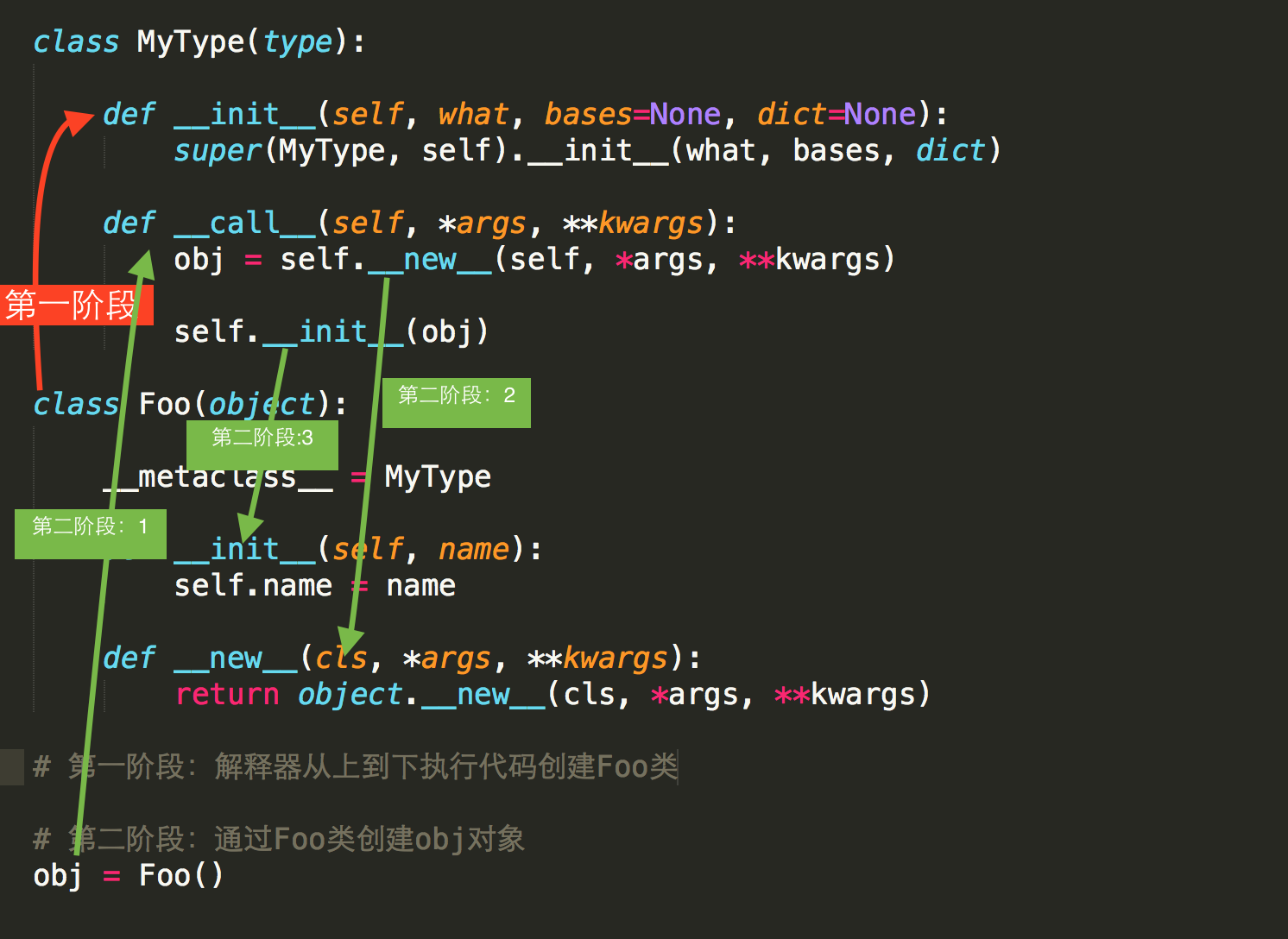1. __doc__ 表示类的描述信息
class Dog(object):
""" 这个类是描述狗这个对象的 """
def func(self):
pass
print(Dog.__doc__)
# 输出: 这个类是描述狗这个对象的
2. __module__ 和 __class__
__module__ 表示当前操作的对象在哪个模块
__class__ 表示当前操作的对象的类是什么

class C: def __init__(self): self.name = 'aa'

from lib.aa import C obj = C() print obj.__module__ # 输出 lib.aa,即:输出模块 print obj.__class__ # 输出 lib.aa.C,即:输出类
3. __init__ 构造方法,通过类创建对象时,自动触发执行。
4.__del__ 析构方法,当对象在内存中被释放时,自动触发执行。
5. __call__ 对象后面加括号,触发执行。
| 注:构造方法的执行是由创建对象触发的,即:对象 = 类名() ;而对于 __call__ 方法的执行是由对象后加括号触发的,即:对象() 或者 类()() |
class Foo:
def __init__(self):
print("__init__")
def __call__(self, *args, **kwargs):
print('__call__')
obj = Foo() # 执行 __init__
obj() # 执行 __call__
6. __dict__ 查看类或对象中的所有成员
class Province:
country = 'China'
def __init__(self, name,count):
self.name = name
self.count = count
def func(self):
print("func")
# 获取类的成员,不包括实例属性
print(Province.__dict__)
# 输出:
# {'__module__': '__main__', 'country': 'China', '__init__': <function Province.__init__ at 0x00000000027EA9D8>,
# 'func': <function Province.func at 0x00000000027EAA60>, '__dict__': <attribute '__dict__' of 'Province' objects>,
# '__weakref__': <attribute '__weakref__' of 'Province' objects>, '__doc__': None}
# 获取 对象obj1 的成员,不包括类属性
obj1 = Province("shandong",1000)
print(obj1.__dict__)
# 输出:{'name': 'shandong', 'count': 1000}
7.__str__ 如果一个类中定义了__str__方法,那么在打印 对象 时,默认输出该方法的返回值。
class Foo:
def __str__(self):
return 'alex li'
obj = Foo()
print obj
# 输出:alex li
8.__getitem__、__setitem__、__delitem__
用于索引操作,如字典。以上分别表示获取、设置、删除数据
class Foo(object):
def __getitem__(self, key):
print('__getitem__', key)
def __setitem__(self, key, value):
print('__setitem__', key, value)
def __delitem__(self, key):
print('__delitem__', key)
obj = Foo()
result = obj['k1'] # 自动触发执行 __getitem__
obj['k2'] = 'alex' # 自动触发执行 __setitem__
del obj['k1'] # 自动触发执行__delitem__
可用于写一个类 封装属于自己的字典,django里面会用到它,用来封装自己的一些底层的东西,用户以为自己是调用的字典,其实是调用的实例。可以对某些key加一些限制,达到使用户可以访问字典,却不能对其进行删除的目的。
9. __new__ __metaclass__
class Foo(object):
def __init__(self,name):
self.name = name
f = Foo("Alex")
上述代码中,f 是通过 Foo 类实例化的对象,其实,不仅 obj 是一个对象,Foo类本身也是一个对象,因为在Python中一切事物都是对象。
如果按照一切事物都是对象的理论:f 对象是通过执行Foo类的构造方法创建,那么Foo类对象应该也是通过执行某个类的 构造方法 创建。
print(type(f)) # 输出:<class '__main__.Foo'> 表示,f 对象由 Foo 类创建 print(type(Foo)) # 输出:<type 'type'> 表示,Foo类对象由 type 类创建
所以,f对象是Foo类的一个实例,Foo类对象是 type 类的一个实例,即:Foo类对象 是通过type类的构造方法创建。
那么,创建类就可以有两种方式:
a). 普通方式
class Foo(object):
def talk(self):
print('hello Alice')
b). 特殊方式
def talk(self):
print('hello Alice')
Foo = type('Foo', (object,), {'talk': talk})
#注意:这里的(object,)是元组的形式,必须后面加一个逗号,如果不加,Python会认为(object)是一个值

def talk(self): print("hello %s" % self.name) def __init__(self,name,age): self.name = name self.age = age Foo = type("Foo",(object,),{"talk":talk,"__init__":__init__})
So ,记住,类 是由 type 类实例化产生
那么问题来了,类默认是由 type 类实例化产生,type类中如何实现的创建类?类又是如何创建对象?
答:类中有一个属性 __metaclass__,其用来表示该类由 谁 来实例化创建,所以,我们可以为 __metaclass__ 设置一个type类的派生类,从而查看 类 创建的过程。


class MyType(type): def __init__(self,*args,**kwargs): print("Mytype __init__") def __call__(self, *args, **kwargs): print("Mytype __call__") obj = self.__new__(self) self.__init__(obj,*args, **kwargs) def __new__(cls, *args, **kwargs): print("Mytype __new__") return type.__new__(cls, *args, **kwargs) class Foo(object,metaclass = MyType): # __metaclass__ = MyType def __init__(self,name): self.name = name print("Foo __init__") def __new__(cls, *args, **kwargs): print("Foo __new__") return object.__new__(cls) f = Foo("Alex") # 输出: # Mytype __new__ # Mytype __init__ # Mytype __call__ # Foo __new__ # Foo __init__
类的生成 调用 顺序依次是 __new__ --> __init__ --> __call__
metaclass 详解文章:http://stackoverflow.com/questions/100003/what-is-a-metaclass-in-python 得票最高那个答案写的非常好
